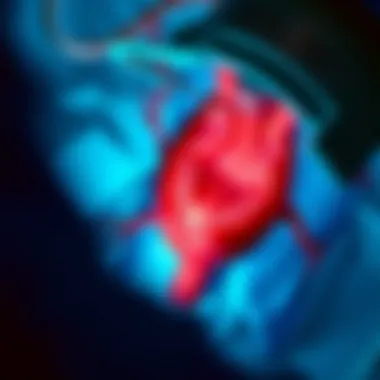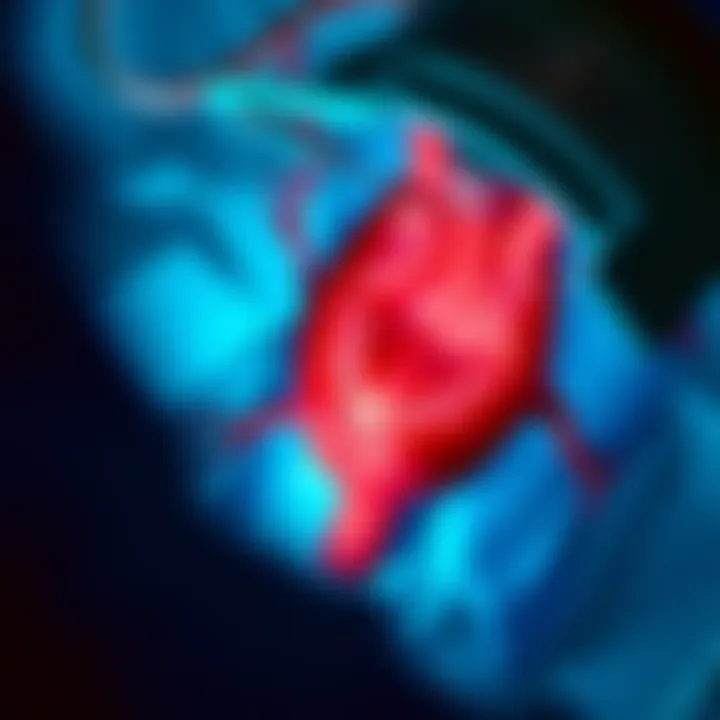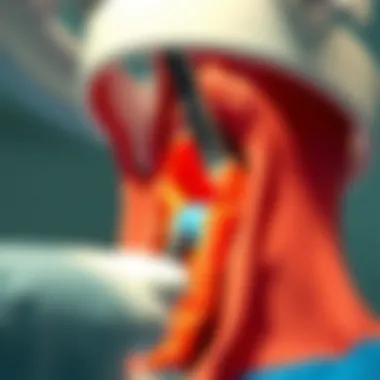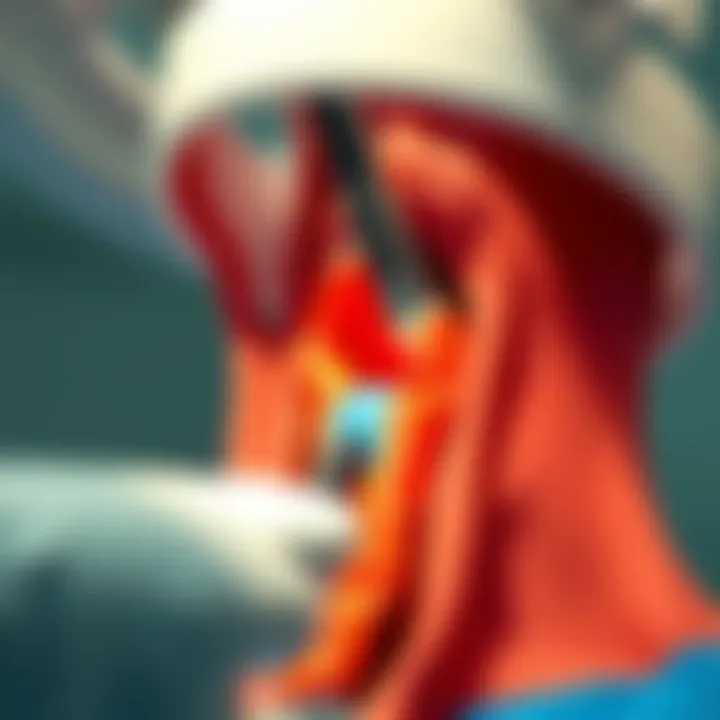Understanding Carotid Artery Stent Surgery


Intro
Carotid artery stent surgery represents a crucial intervention in the treatment of carotid artery disease. This procedure aims to prevent serious complications, such as strokes, by addressing blockages in the carotid arteries – the primary vessels supplying blood to the brain. Understanding the intricacies of this surgery involves more than just recognizing surgical techniques; it requires grasping the underlying causes of carotid artery disease, evaluating patient eligibility, and considering the potential risks and outcomes associated with the procedure.
As we unfold this topic, it's vital to delve into key concepts and terminology that provide a foundation for this complex medical procedure. The language of medicine can often seem daunting, but by breaking it down into manageable parts, one can gain clarity on the subject. This examination aims to ensure that readers—be they students, researchers, or healthcare professionals—leave with a well-rounded comprehension of carotid artery stent surgery, including its relevance and impacts on health outcomes.
From surgical procedures to post-operative care, each element plays a defining role in the larger picture of managing carotid artery disease efficiently. In the following sections, we will explore these components in depth, providing not just a narrative but a comprehensive guide to navigating this significant medical practice.
Overview of Carotid Artery Disease
Carotid artery disease ranks high among critical vascular conditions, yet many aren't fully aware of its intricacies. Understanding its various manifestations is crucial for recognizing the gravity of the problem and the necessity of interventions like stent surgery. After all, these arteries are the body's main highways for blood to the brain, and any hiccup can lead to serious repercussions.
Definition and Importance
Carotid artery disease typically refers to the narrowing or blockage in the carotid arteries, usually due to a buildup of fatty deposits known as atherosclerosis. Understanding this condition is not just academic; it has immediate implications for health care, emphasizing early detection and intervention. This importance cannot be overstated, as carotid artery disease stands as a significant risk factor for strokes, which are among the leading causes of death worldwide. Identifying and comprehending this disease paves the way for timely and effective treatment options.
Types of Carotid Artery Conditions
There are several types of conditions affecting the carotid arteries, each presenting unique challenges and treatment paths.
Stenosis
Stenosis refers to the narrowing of the carotid arteries. This happens when plaque accumulates on the artery walls, reducing blood flow. What sets stenosis apart is its often asymptomatic nature until a significant level of blockage exists. According to many healthcare experts, understanding stenosis is critical because it's a leading cause of strokes. Early diagnosis, often through ultrasound or other imaging techniques, can help mitigate risks. However, treatment options—like carotid artery stenting—are necessary in severe cases, providing a direct path to restoring proper blood flow. One main advantage of treating stenosis is its potential for preventative measures, which can shield a patient from more severe complications down the road.
Aneurysm
A carotid artery aneurysm involves a bulge that forms in the artery wall, which can potentially rupture, leading to severe hemorrhage. This condition differs significantly from stenosis in that it often requires immediate and decisive action. The precarious nature of aneurysms mandates close monitoring, and surgical options exist depending on the size and risk factors. The key characteristic of aneurysms is their unpredictable nature, and timely intervention may significantly reduce the likelihood of catastrophic events. These features enrich the discussion about cardiovascular health in the article.
Thrombosis
Thrombosis occurs when a blood clot forms inside the carotid artery. This can arise due to a number of factors, including pre-existing conditions and lifestyle choices such as smoking or sedentary behavior. Those who understand thrombosis recognize its potential for both instant danger and long-term health repercussions. A critical aspect of discussing thrombosis is its contribution to ischemic strokes, where blood supply is cut off. The unique feature here is that thrombosis can sometimes be resolved with medication, but it might necessitate surgical intervention if clotting does not resolve. Therefore, this facet draws attention to the intricate balance required for managing carotid artery conditions effectively.
In summation, recognizing the various forms of carotid artery disease allows for a thorough comprehension of stent surgery and related treatments. Knowledge in this area not only equips healthcare providers to take decisive actions but also fosters informed patient discussions about their ongoing care.
Indications for Carotid Artery Stent Surgery
Understanding the indications for carotid artery stent surgery is crucial. This section examines various patient categories and their specific scenarios that may necessitate the intervention. The procedures are generally prioritized according to a patient's symptoms and overall health, which play a significant role in determining whether stenting is the best course of action. Each indication offers insights into the complexities surrounding carotid artery disease management, underscoring that patient outcomes can hinge on timely decision-making.
Symptomatic Patients
Transient Ischemic Attack
A transient ischemic attack (TIA) is often dismissed as a mere warning bell, but it represents a critical juncture. TIAs occur when there's a temporary reduction in blood flow to the brain, leading to brief neurological deficits. These changes can last anywhere from a few minutes to up to 24 hours. The importance of recognizing a TIA lies in its high correlation with future strokes, with many analyzing it as a prelude to more serious events.
Key reasons to consider stent placement post-TIA include the urgency of addressing potential stenosis and preventing subsequent cerebrovascular incidents. Patients who have experienced a TIA are often perceived as prime candidates for stenting, as this method may stabilize their condition and provide immediate relief against stroke risks. However, TIAs should not be taken lightly; their temporary nature can mislead some into thinking all is well, while medical intervention is clearly needed.
Stroke
Stroke represents one of the most alarming signals that an individual can experience. It can happen with little warning, often resulting from the same issues leading to TIAs. The stakes are high; every minute matters when dealing with a stroke as brain tissue can begin to die rapidly without blood flow. Stenting before or after a stroke might, in some cases, salvage more brain function.
This section emphasizes the urgency that surrounds patients who have had a stroke. They might require immediate stenting, especially if they show significant carotid artery blockage. A unique aspect of stroke considerations is how quickly interventions need to be implemented - time is in the balance. In some instances, the timing for stenting can be difficult to gauge because it hinges on various factors, including blood pressure stability and the risk of further complications.
Asymptomatic Patients
High-Level Stenosis
High-level stenosis, often defined as 70% or more narrowing of the carotid artery, presents a different set of considerations. These patients may not showcase any clear symptoms, yet their anatomical condition places them at significant risk for cerebrovascular incidents. Hence, it’s vital to approach these patients with care.
The distinguishing feature of high-level stenosis is its silent nature. Many asymptomatic individuals might not feel that anything is amiss, even while at risk. The decision to perform stent surgery in this context often hinges on the patient's overall health profile and specific risk factors. While stenting could be a proactive measure to mitigate future strokes, there’s an inherent concern about undertaking procedures when the patients display no immediate symptoms, which could lead to unnecessary risks and complications.
Patient's Health Status
It’s essential to evaluate a patient’s overall health when considering carotid artery stent surgery. Factors like age, existing health conditions, and lifestyle significantly influence the treatment pathway. A robust health status may tip the scales towards intervention, while an individual with multiple health issues might face greater risks during the procedure.
The distinctiveness of this consideration lies in the concept of individualized treatment. For example, a younger, healthier patient showing signs of carotid artery narrowing might be a better candidate for stenting than an elderly patient with comorbid conditions, even if both display similar blockage levels. This personal approach to patient health status must be carefully weighed, as it factors into both the immediate risks and long-term outcomes following surgery.
In this segment, it's clear that the indications for carotid artery stent surgery are multifaceted, dictated by symptoms, the severity of stenosis, and the overall healthiness of each patient. An astute understanding of these factors allows healthcare providers to make informed decisions on when to pursue stent interventions in order to effectively mitigate the risks associated with carotid artery disease.
Preoperative Assessment
A crucial step in the journey towards carotid artery stent surgery is the preoperative assessment. It sets the stage for a successful outcome by providing a comprehensive picture of the patient’s health and the overall condition of the carotid arteries. Understanding the patient’s profile aids in making informed decisions regarding the appropriateness of the procedure, especially when balancing the benefits against potential risks.
The assessment process involves multiple diagnostic techniques and reviews of the patient’s medical history, ensuring no stone is left unturned. This careful consideration serves not only to identify the underlying causes of carotid artery disease but also to tailor the surgical approach to the individual needs of the patient. It allows medical professionals to gauge how various risk factors might affect the surgery and recovery, which is paramount in achieving optimal long-term outcomes.


Diagnostic Imaging Techniques
Ultrasound
Ultrasound is often the first-line imaging technique employed in evaluating the carotid arteries. Its key characteristic lies in being a non-invasive method that uses sound waves to create real-time images of the arteries. This immediacy is particularly beneficial as it allows physicians to quickly assess the presence and severity of stenosis or plaques within the arteries.
A unique feature of ultrasound is its ability to measure blood flow using Doppler ultrasound. This means not only can the structure of the arteries be seen, but also, the functionality can be assessed in terms of blood flow abnormalities. Although ultrasound has its advantages, such as no exposure to radiation and ease of accessibility, it can sometimes present limitations in differentiating the nature of the plaque, which may require more detailed imaging modalities.
MRI
Magnetic Resonance Imaging (MRI) serves as a valuable tool in the evaluation process due to its remarkable detail in soft tissue contrast. The key characteristic of MRI is its ability to provide a three-dimensional view of the blood vessels and surrounding structures without the use of ionizing radiation. This can be crucial for patients who may be sensitive to radiation, perhaps due to prior procedures or increased risk factors.
A unique feature of MRI is its capability to visualize not just the arteries but also to identify the biochemical nature of the plaques, which might help doctors determine the risk of rupture. However, MRI can be time-consuming, and the availability of the technology can often be a hurdle, depending on the facility.
CT Angiography
In contrast, Computed Tomography Angiography (CT Angiography) is known for its speed and efficiency. This modality combines X-ray images taken from various angles to create a comprehensive picture of the blood vessels. The key characteristic of CT Angiography is its ability to deliver high-resolution images very quickly, making it ideal for emergency situations where time is of the essence.
What stands out about CT Angiography is its capacity to visualize the arterial tree, permitting evaluations of both distal and proximal segments of the carotid artery. However, the drawback here includes exposure to radiation and the requirement for contrast agents, which are not suitable for every patient, especially those with renal insufficiencies.
Medical History and Risk Factors
Hypertension
Hypertension is a significant risk factor for carotid artery disease. It causes added stress on arterial walls, promoting atherosclerosis formation. The key characteristic of hypertension as a risk factor is its widespread prevalence; many individuals may be unaware they have elevated blood pressure. By recognizing hypertension, healthcare providers can strategize effective interventions, which may include lifestyle modifications and medication management.
Unique to hypertension is its ability to affect outcomes significantly; controlled blood pressure can markedly reduce complications related to surgeries, including stenting. The challenge lies in its management, as patients often require continuous monitoring and adjustment of their treatment regime.
Diabetes
Similarly, diabetes plays a crucial role in the context of carotid artery disease. It hastens the development of atherosclerosis, complicating the clinical picture. A distinctive aspect of diabetes is its multiplicative risk; individuals with diabetes are at a much higher risk for cardiovascular issues compared to those without the condition.
Moreover, diabetes is often associated with other comorbidities, such as hypertension and dyslipidemia, making it a focal point in preoperative assessments. The benefits of recognizing diabetes beforehand allow healthcare providers to implement appropriate glycemic control strategies, which are important in enhancing surgical outcomes.
Smoking Status
Lastly, smoking status should not be overlooked in preoperative assessments. Smoking is a notorious contributor to vascular disease, significantly elevating the risk for carotid artery issues. The key characteristic of current or past smoking habits is the inflammatory and damaging effects on the vascular system, which can impede healing following a stenting procedure.
Unique to smoking is its modifiable nature; cessation of smoking can lead to notable improvements in vascular health. Understanding a patient’s smoking history helps to inform care strategies postoperatively. In a broader context, it reinforces the importance of lifestyle changes in mitigating future risks of cardiovascular disease exiting beyond surgical interventions.
"Considering all these elements distinctly informs the medical team, ultimately shaping the approach to the surgical procedure and patient care."
In summary, a thorough preoperative assessment including diagnostic imaging and a critical review of medical history can considerably influence the success and recovery of carotid artery stent surgeries. Each element contributes uniquely, building a comprehensive portrait that guides tailored interventions.
The Carotid Artery Stent Procedure
The carotid artery stent procedure posits itself as a critical intervention within the overarching discourse of carotid artery disease management. This procedure not only aims to alleviate the immediate dangers posed by arterial blockages but also paves the way for long-term vascular health. By utilizing stenting, healthcare providers can maintain the patency of arteries, reducing the risk of future ischemic events. As procedural techniques evolve and improve, understanding the specific elements, benefits, and considerations of carotid artery stent procedures becomes essential for both practitioners and patients alike.
Procedure Overview
The carotid artery stent procedure typically occurs in a specialized setting, usually a catheterization lab, and can often be performed under local anesthesia. During the procedure, a catheter—a thin, flexible tube—is inserted into the femoral artery in the groin and is then guided up to the carotid arteries in the neck. Once in position, the catheter helps deliver a stent, which is a small mesh-like tube, directly to the site of the blockage.
The stent is then expanded, typically through the inflation of a balloon, and it remains in place to support the artery against collapsing. This process can greatly enhance blood flow and significantly decrease the chances of experiencing further strokes or transient ischemic attacks.
Types of Stents Used
Self-Expanding Stents
Self-expanding stents represent a significant element in the realm of carotid artery stenting. These stents, usually made from flexible materials like nitinol, have the remarkable ability to expand on their own when released from the delivery catheter.
Key Characteristics:
Self-expanding stents are designed to adapt to the shape of the artery upon deployment. This characteristic ensures a snug fit against the arterial wall, which is crucial for maintaining blood flow and minimizing the risk of restenosis, or re-narrowing of the artery.
Benefits:
The adaptability and flexible nature mean that they can navigate through varying arterial diameters. Additionally, since they deploy without the need for balloon inflation, they can save time during procedures and reduce the risk of complications associated with ballooning. However, they do have some disadvantages. Their radial strength might be less than that of balloon-expandable stents in certain scenarios, which could be a consideration for the surgeon based on the patient's specific condition.
Balloon-Expandable Stents
On the other hand, balloon-expandable stents are often constructed from materials like stainless steel and require the use of a balloon for deployment. Once positioned at the site of the stenosis, the balloon is inflated, expanding the stent to its functional shape.
Key Characteristics:
One feature that sets balloon-expandable stents apart is their ability to provide greater radial strength compared to some self-expanding alternatives. This quality can help prevent early stent collapse and allows for the treatment of more extreme cases of stenosis.
Benefits:
While highly effective, especially in heavily calcified lesions, these stents may pose an increased risk of complications since the success of their expansion is highly dependent on the balloon technique. During insertion, there’s a slight risk associated with the use of balloons, including vascular damage and acute arterial dissection.
In summary, understanding both types of stents—self-expanding and balloon-expandable—is critical when discussing the carotid artery stent procedure. Each option has its unique pros and cons, making the choice of stent central to the surgical strategy.
Postoperative Care


Postoperative care is a critical aspect of the overall journey following carotid artery stent surgery. It's during this phase that patients begin their recovery, and attentive care can significantly influence outcomes. Here, understanding the nuances of both immediate recovery and follow-up appointments can make all the difference in ensuring a successful rehabilitation and in minimizing long-term risks.
Immediate Recovery Setting
The immediate recovery setting refers to the time spent in the hospital right after the surgical procedure. Patients are typically monitored in a specialized unit where healthcare professionals observe them closely for any signs of complications. This close supervision is essential. For example, patients may need to be evaluated for symptoms like dizziness or changes in consciousness, which might indicate a complication that needs prompt attention.
During this phase, several factors come into play:
- Vital Signs Monitoring: Continuous tracking of heart rate, blood pressure, and oxygen levels is vital. Sudden changes in vitals may signal a need for immediate intervention.
- Pain Management: Proper pain control measures are put in place to ensure comfort without over-reliance on pain medications.
- Fluid and Nutrition: Gradual introduction of oral fluids and diet is crucial. Depending on the patient’s recovery status, a nutritious diet can help in the healing process.
Follow-Up Appointments
Follow-up appointments are scheduled typically within a week or two after the surgery. These appointments are not just routine check-ups; they play a significant role in the long-term success of the procedure. At these visits, practitioners assess the patient’s recovery, ensuring everything is healing well and checking for any complications. Follow-ups can serve as reassurance to patients, solidifying their path to recovery.
Monitoring
Monitoring during follow-up appointments entails a detailed evaluation of symptoms and test results. Health professionals take a close look at the stent's functionality and detect any potential issues early on.
Key Characteristic: The specific aspect of monitoring that stands out is the risk assessment. Identifying warning signs early can lead to interventions that might prevent more severe complications down the line. For instance, an unexpected rise in blood pressure can initiate further investigation to rule out something more serious.
Unique Feature: One of the advantages of effective monitoring is the incorporation of advanced imaging techniques, such as ultrasound, to visualize the stent and the surrounding arterial area. This non-invasive approach provides real-time insights, allowing healthcare providers to proactively manage any arising concerns.
Medication Adjustments
Medication adjustments are often necessary after carotid artery stent surgery. These adjustments ensure that patients are on the right regimen to prevent complications like thrombus formation.
Key Characteristic: It highlights seamless coordination between healthcare providers and patients. When a patient attends their follow-up, their medications may be carefully reviewed and modified, if needed, based on their health progress and current symptoms.
Unique Feature: Another aspect to consider is that some patients may need anticoagulant therapy. This could be a double-edged sword, as while it prevents clotting, it also raises the risk of bleeding. Careful monitoring is crucial to find that balance.
"Preventative measures taken post-surgery can mean the difference between a bumpy road to recovery and a smooth sail."
For more information on the recovery process after carotid artery stent surgery, consider visiting resources such as Mayo Clinic or American Heart Association.
Potential Complications
Understanding the potential complications that can arise from carotid artery stent surgery is crucial. Not only does it help healthcare professionals take preventive actions, but it also prepares patients for what may come post-surgery. This section digs into the various short-term and long-term risks, painting a picture of the complexities involved in post-operative care and patient safety.
Short-Term Risks
Short-term risks directly impact immediate recovery and can dictate the overall success of the surgery. Being aware of these potential pitfalls can assist both doctors and patients in managing expectations and formulating effective response plans.
Stroke
The risk of stroke following carotid artery stenting cannot be brushed off lightly. It serves as a sobering reminder of the procedure's inherent risks. A stroke occurs when blood flow to part of the brain is interrupted, showcasing the very kind of issues this surgery aims to alleviate.
The key characteristic of this complication is its potential immediacy; patients can experience a stroke within days of the operation. The urgency of this risk becomes clear when we consider that swift reactions are often needed to limit brain damage. A unique feature of strokes as a complication is their varied presentation—some may have sudden weakness on one side while others might struggle with speech. The advantage of understanding this risk is that it encourages better monitoring during the recovery phase.
Bleeding
Bleeding post-procedure is another immediate concern that can jeopardize recovery. While bleeding may manifest as a minor issue on the surface, it can escalate urgently if not addressed promptly. The surface appearance of a bruise might seem harmless, yet beneath can lurk a problematic condition if there's excessive bleeding from the incision site.
Understanding bleeding as a complication helps empower both patients and surgeons to keep a vigilant eye. A unique aspect of bleeding is the range it covers—from minor oozing to major hemorrhage. Knowing what to look for can vastly improve outcomes for the patient.
Arteriovenous Fistula
An arteriovenous fistula can be a rare but serious complication arising from the placement of a stent. Essentially, it’s a tangle between an artery and a vein. Its emergence is often unexpected, and once formed, it requires intervention to rectify the issue.
The major risk here is that this complication might not present any symptoms initially, rendering it elusive until a serious problem occurs. Recognizing the potential for this condition can lead to earlier diagnostics and treatment, which, ultimately, can enhance patient outcomes.
Long-Term Risks
Long-term risks can influence not only survival rates but also a patient's overall quality of life. These complications can linger months or even years after the stent is placed.
Restenosis
Restenosis is the term used when an artery narrows again after treatment. This can come as a disappointment to patients who had hoped for a clear road ahead. The key characteristic of restenosis is its potential to occur within months post-surgery, creating a sense of urgency for continuous monitoring. Its uniqueness lies in the dual nature of the complication; while it signifies the body’s attempt to heal, it may lead back to symptoms akin to those that initiated surgery.
The upside of identifying restenosis early can be critical, allowing for timely intervention and preventing further complications.
Stent Thrombosis
Stent thrombosis is a clot formation that occurs at the site of the stent, which can happen acutely or over time. This can severely compromise the treatment’s effectiveness, reinstating blockages when a patient thought the dangers of a stroke had been mitigated. The function of a stent essentially hinges on ensuring sustained blood flow, thus thrombosis presents a unique paradox where the very tool used to correct an issue becomes a silent risk.
Recognizing the signs and risks associated with stent thrombosis can allow for better medication planning, reducing chances for clot formation.


For more information about related health procedures, visit Mayo Clinic, NHS, and American Heart Association.
Long-Term Outcomes and Efficacy
Long-term outcomes and efficacy play a pivotal role in evaluating the success of carotid artery stent surgery. Beyond the immediate post-operative recovery, the focus shifts to how patients fare after the initial healing period. Understanding these long-term aspects is crucial for both clinicians and patients alike, as they can significantly shape treatment strategies and expectations.
Evaluating the long-term results encompasses various elements such as survival rates, quality of life, and the durability of the stent itself. Key considerations include whether the surgery successfully reduces the risk of future stroke, improves daily functioning, and enhances the overall well-being of the patient.
Survival Rates
The survival rates following carotid artery stent surgery are often a primary concern for patients considering the procedure. Numerous studies have shown that the majority of patients can expect favorable outcomes in terms of longevity. Most data suggest a high survival rate of around 90% or more at five years post-surgery for patients who undergo carotid artery stenting, particularly those deemed appropriate candidates.
Factors that can influence these outcomes include:
- Patient’s age and general health status: Older patients or those with multiple comorbidities may have different survival expectations compared to younger, healthier individuals.
- Pre-existing conditions: Conditions like diabetes or severe heart disease can complicate recovery and are associated with lower survival outcomes.
- Follow-up care: Regular follow-up visits and adherence to prescribed medication regimes are critical in maintaining health and preventing complications.
In sum, while the statistics are encouraging, the individual circumstances surrounding each patient will ultimately inform true survival rates after stenting procedures.
Quality of Life Post-Surgery
Quality of life after carotid artery stent surgery is another integral component of long-term efficacy. Many patients report significant improvements in their daily activities and a marked decrease in the fear of recurrent strokes or transient ischemic attacks (TIAs). This improved quality of life can often be attributed to:
- Reduced symptoms: Once the stenting procedure is successful, many find relief from symptoms like difficulty in speaking or weakness on one side of the body, which can greatly enhance day-to-day living.
- Increased mobility and independence: Individuals can often return to normal routines, including work and leisure activities, with a renewed sense of freedom.
- Emotional well-being: The anxiety and stress that often accompany a diagnosis of carotid artery disease can diminish post-surgery, leading to better mental health outcomes.
However, it's worth noting that not all patients may experience the same level of improved quality of life. Follow-up studies have identified that some individuals may continue to face challenges, such as post-stroke syndromes or other complications, which can potentially affect overall life satisfaction.
"The impact of carotid artery stent surgery extends beyond survival; it intertwines with the very fabric of everyday experience, shaping not just how long patients live, but how well they live."
Alternative Treatments
When discussing carotid artery disease, it’s vital to explore not just surgical options but also the alternatives that can effectively manage the condition. Alternative treatments can serve as adjuncts to surgical interventions, or in some cases, provide a pathway for patients who may not be candidates for stenting surgery. These alternatives include medical management and endarterectomy, both of which have their own merits and considerations.
Medical Management
Medical management is often the initial line of defense against carotid artery disease. This approach emphasizes controlling risk factors and involves the use of medications and lifestyle modifications to improve patient outcomes.
- Medications:
- Lifestyle Changes:
- Antiplatelet Therapy: Aspirin or clopidogrel can reduce the risk of stroke by preventing blood clots.
- Statins: These help in lowering cholesterol levels, which is crucial for reducing plaque buildup in arteries.
- Antihypertensives: These help in managing high blood pressure, which is a significant risk factor for arterial disease.
- Diet: Adopting a heart-healthy diet that is low in saturated fats and high in fruits and vegetables can drastically impact overall vascular health.
- Exercise: Regular physical activity can enhance cardiovascular fitness and aid in weight management.
- Quit Smoking: This is perhaps one of the most influential steps a person can take to improve their vascular health.
In many cases, patients opt for medical management in tandem with surgical options, creating a more comprehensive treatment strategy that addresses both symptoms and underlying causes. Patients must remain vigilant and maintain regular check-ups with their healthcare providers to monitor their condition.
"Managing carotid artery disease requires commitment to both medication and lifestyle changes; it’s a long road, but results are achievable."
Endarterectomy
Endarterectomy is a surgical procedure that involves the removal of plaque from the carotid arteries. Though it falls under the umbrella of surgical interventions, it is necessary to discuss its process and when it might be preferred over stenting.
- Indications for Endarterectomy:
- Benefits:
- Patients with symptomatic stenosis of 50% or greater often qualify for this procedure, especially if they have a history of transient ischemic attacks or strokes.
- It’s also indicated for asymptomatic patients with more than 70% stenosis who are at high risk of stroke.
- Immediate Results: Patients may experience an immediate reduction in symptoms such as dizziness or weakness.
- Long-Lasting Relief: It can provide long-term benefits, as plaque removal can prevent future strokes more effectively for certain patients.
Despite its advantages, endarterectomy carries its own set of risks, including nerve injury and infection. The decision of whether to perform an endarterectomy versus stenting often hinges on individual patient circumstances, including artery anatomy and general health.
Ultimately, understanding these alternative treatments allows both patients and healthcare professionals to make informed decisions regarding the management of carotid artery disease, balancing risks and benefits in pursuit of optimal outcomes.
Culmination
The topic of carotid artery stent surgery is crucial, not only for the medical community but also for patients grappling with carotid artery disease. This procedure represents a significant advancement in managing conditions that can lead to severe complications like stroke. Through the various sections of this article, we uncovered vital elements that underscore the importance of stent surgery, from understanding patient eligibility to the intricacies of postoperative care.
Summary of Key Findings
Stenting has demonstrated efficacy in treating carotid artery stenosis, particularly in patients presenting with severe symptoms. It's been shown that:
- Symptomatic patients, especially those who have experienced transient ischemic attacks, are prime candidates for this intervention.
- Asymptomatic patients with high-level stenosis also benefit, although risk assessment is fundamental to guide their management.
- Complications, while present, are often mitigated by dedicated postoperative care and monitoring strategies, emphasizing the need for follow-up appointments.
Additionally, research indicates that stenting, when appropriately indicated, can lead to improved quality of life post-surgery. Long-term survival rates, particularly when weighed against alternative treatments like medical management or endarterectomy, provide a compelling case for its acceptance as a standard care option.
Future Directions in Research
Moving forward, the field of carotid artery stent surgery holds promise for further refinement through research focusing on several crucial areas, including:
- New stent designs that may enhance patient outcomes, reducing complications such as restenosis.
- Comparative studies assessing the long-term effects of stenting versus traditional surgical methods can illuminate best practices for various patient profiles.
- Genetic and biomarker studies that could help identify which patients may benefit most from stenting, paving the way for personalized treatment approaches.
Future research efforts could also place a spotlight on the optimization of postoperative care protocols to minimize complications and enhance recovery timelines. As knowledge expands, the goal should be not only to improve surgical outcomes but also to elevate overall patient care in the realm of vascular health.
Understanding these nuances surrounding carotid artery stent surgery contributes significantly to its role as a key player in managing carotid artery disease effectively and safely. Engaging with ongoing research will ensure the longevity and relevance of treatment protocols in the ever-evolving landscape of cardiovascular medicine.







